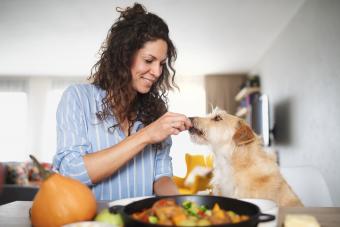
Every dog owner has sat down with a big bowl of popcorn, only to have their dog gobble up a popped kernel or two. Not to worry; a few pieces of popcorn are unlikely to cause your dog any health issues. However, not all popcorn is safe for dogs to eat.

Air-popped, Unsalted Popcorn is Safe
How popcorn is prepared -- and what it is prepared with -- determines how healthy it is for your dog to eat. The good news is, fully popped kernels that are served plain are generally a safe treat for your dog.
However, not all methods of preparation are good for your pet. Avoid feeding any popcorn that has been heated in oil, fried, salted, buttered, dipped in caramel, or flavored in any way. The worst sort of popcorn for dogs is dipped in chocolate, because cocoa is toxic to dogs.
Also, avoid feeding microwave-popped popcorn. Although you can find plain microwave popcorn, there are some concerns about chemicals in the bags -- called perfluorooctanoic acid, a type of perfluorinated compound -- being unhealthy for dogs and humans. Most microwave popcorn brands add a lot of salt and other ingredients that are equally unhealthy for dogs.
The healthiest way to offer popcorn to your dog is to air pop it. Served without butter and salt, this is a good way to treat your pet. Although popcorn doesn't offer any particular health benefits, many dogs enjoy it as a snack, and appropriately prepared popcorn can serve as a training aid.
How Much Popcorn is Enough?
As with nearly any dog treat, moderation is key. A few pieces of popcorn are fine, but don't overdo it. Follow the 10 percent rule, which states that treats should make up no more than 10 percent of your dog's daily calorie intake.

Popcorn is low in calories, but high in carbohydrates and fiber. Typically, two tablespoons of unpopped kernels -- which makes about a 3-cup serving -- of plain, air-popped kernels has around 100 calories in it, as well as 1 gram of fat and 4 grams of fiber. Error on the side of caution, and give your dog no more than five to 10 pieces of popcorn in a serving, depending on your dog's body weight and treat intake.
Be sure not to offer more than a piece at a time to avoid problems with swallowing. Don't give your dog access to unpopped kernels, or those that have partially popped. The hard outer skin -- known as the hull -- may get stuck in their teeth, and there is a chance a hull can cause discomfort or even a choking hazard if your dog swallows it.
Air Popping for a Treat
There are several ways to air pop your popcorn. Commercial air poppers are easy to use, but you don't need one of these to offer popcorn to your dog. You can even air pop your popcorn in the microwave using a paper bag or a reusable microwave popcorn container. Air fryers also work to air pop kernels.
If you don't have an air popper or any special equipment, you can place a serving of unpopped kernels in a plain paper bag and put it in your microwave. Fold and crease the bag to trap in moisture, which helps the kernels pop. Then, microwave for two to three minutes on high heat.
Air fryers are increasingly popular, and these kitchen devices are easy to use to air pop popcorn. Line the fryer's basket or shelf with aluminum foil, forming a bowl to catch the popping kernels. Preheat the unit to 400 degrees if it doesn't have a popcorn setting, and place the desired serving on the foil. cook for eight to 10 minutes, or until you hear the popcorn stop popping.
Popcorn is a Safe Treat for Dogs
Your dog will probably prefer the flavorful, buttered and salty popcorn you make for yourself when you stay home for a cozy movie night. Don't give in, however, and prepare a plain treat for your pup to help with training, or just because. Stay away from the added fats and high sodium content of microwaved popcorn, keep portion sizes small, and your dog's veterinarian will thank you in the end.







